New York Giants Week 6: First Look at Baltimore Ravens’ Offense
London was calling, and in the span of 30 minutes, the New York Giants answered with their most dominant performance of the season.
In Week 5, the Giants flew across the pond to partake in the NFL’s second London game of the year, their 17-2 second-half comeback shocking the Green Bay Packers in what was a 27-22 final. Earning their fourth victory under head coach Brian Daboll, the franchise is off to its best start since 2009.
With an incredibly banged-up wide receiver room, the Giants continued to remain competitive in games, put points on the board, and believe in themselves--all key steps in their journey toward a return to relevance in the league.
Next for the Giants is a home date at MetLife Stadium to host the Baltimore Ravens (3-2). The two franchises are meeting for the eighth time in the Super Bowl era, splitting the previous two meetings (Baltimore holds a 5-2 advantage in the all-time series). In 2020, the Giants visited the Ravens at M&T Bank Stadium, where the home team took a definitive 27-13 victory.
Among the key storylines ahead of this weekend will be defensive coordinator Wink Martindale, who spent the previous nine years with the Ravens, seeking revenge against his old team by focusing, partly, on slowing down one of the more dynamic offenses as led by quarterback Lamar Jackson.
A rising star in the league because of his dual-threat abilities, Jackson allows the Ravens’ offense to torch weary defenses through the air or with the quarterback’s nifty legs.
While the 2018 first-round pick has mustered nearly 11,000 passing yards in five seasons (including three straight with at least 2,700 yards), Jackson has also accumulated 4,047 yards rushing the football with two seasons finishing over the 1,000 mark.
Outside of Jackson, the Ravens’ rushing attack tends to lean towards mediocre. Through the first four weeks, Baltimore has 568 yards, three touchdowns on the ground, and 316, and two of those belong to the quarterback.
The only other ball carrier to surpass 100 yards this season is running back Justice Hill (125), leaving much to be desired in the department when the ball is out of Jackson’s hands.
Tight end Mark Andrews has become Jackson’s favorite target downfield and leads the team’s receiving core with 24 receptions for 260 yards and three touchdowns, the latter ranking third among players in his position. Wide receivers Rashod Bateman, Devin Duvernay, and tight end Isaiah Likely also get in the mix, offering a variety of versatile playmakers at Baltimore’s disposal.
The Ravens finished the 2021 season with a subpar 8-9 record, but they boasted one of the most efficient offenses in moving the football through the trenches. While ranking 17th in total points and no higher than 13th in passing categories, they were sixth-best in total yards (6,440), fifth in first downs (394), and in the top 10 in rushing attempts, yards, touchdowns, and average yards gained.
Many of those numbers have faded so far in 2022, but the Ravens are now hot in scoring points (ranking third with 119) and earning great average yards per play (7.0 and 5.4 yards per pass and snap, respectively). The Giants’ defense will surely have their work cut out for them against a younger, more versatile Jackson and his offense, who can find different ways to maneuver past even the most pressure-heavy defenses as New York’s.
Let’s take a deeper look at the playmakers on the Baltimore Ravens offense and what the Giants defense must watch out for when they take the field on Sunday.
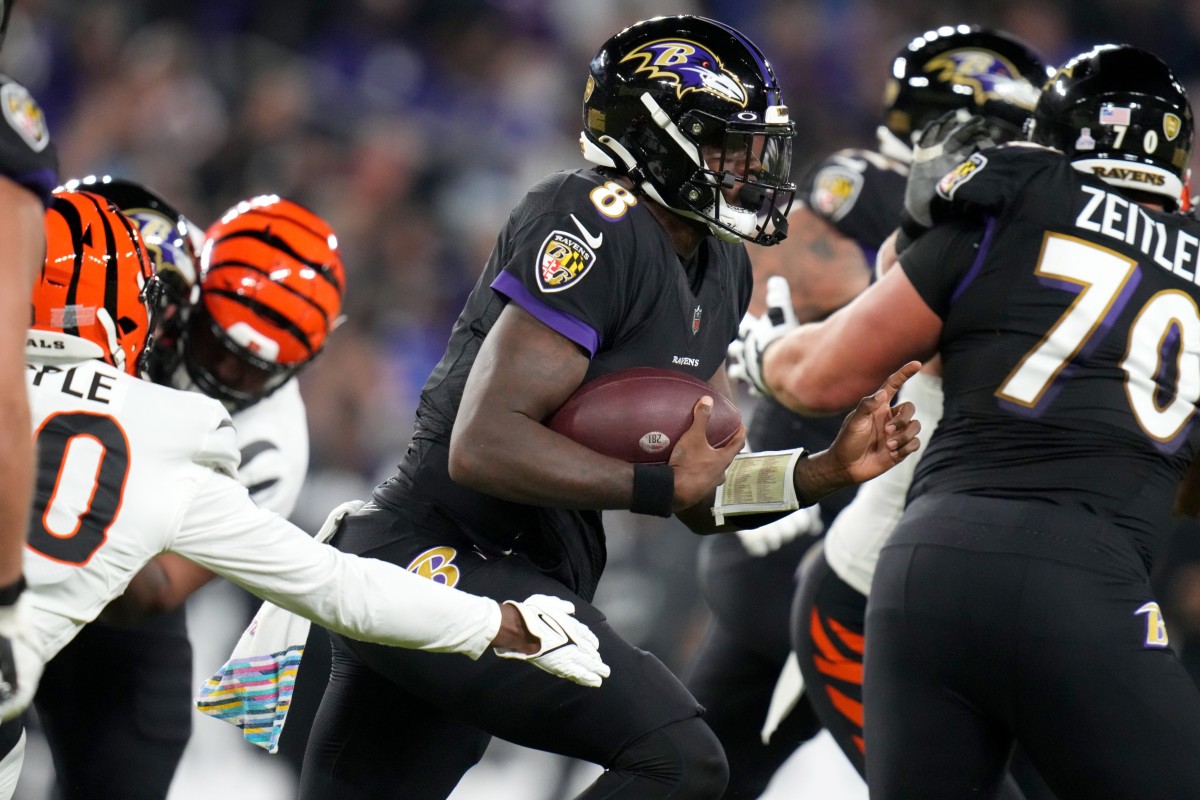
Quarterback
With three consecutive productive seasons in his rearview mirror, quarterback Lamar Jackson still faces a “prove himself” campaign in 2022.
Despite posting a combined 8,766 passing yards and 78 touchdowns through the air and 2,978 yards and 16 touchdowns on the ground over that span, the Louisville product has yet to lead the Ravens beyond the AFC Divisional round, and concerns linger around the organization with handing him a hefty contract extension.
The two sides couldn’t reach an agreement before the season opener, leaving Baltimore’s 2018 first-round pick to bet on himself and showcase his worth with another highlight season in the contract year.
Last season, Jackson continued his impressive run amid a mediocre finish for Baltimore, tallying 2,882 yards and 16 touchdowns while rushing for 767 yards and two scores on the ground in his first losing campaign. Through the first five games of 2022, he has amassed 95 completions for 1,067 yards and 12 touchdowns, and 374 yards rushing the ball.
Coming out of college as the No. 32 overall selection, it was clear the rest of the NFL skipped over Jackson because they couldn’t evaluate him against the typical standards of the quarterback position. The exact reason for that is he is far from the prototypical gunslinger of old, instead being an explosive playmaker with the speed, athleticism, and dual-threat abilities to single-handedly take over football games.
At his core, Jackson is a flashy quarterback with the prowess to create instant home run plays using both his arms and legs. Drawing comparisons to Michael Vick, the 25-year-old thrives when integrated into an offense that promotes the use of RPOs (run-pass options) with mixes of heavy play action, both schemes the Ravens have deployed since drafting their hopeful franchise guy.
Having an experienced offensive line protecting him and the quickness to escape pressure if necessary, Jackson remains cool and poised in the pocket of nearly every play until the moment of the ultimate decision. Rarely does he get risky with managing the offense, usually electing to a simpler play or loss of yards than releasing the haphazardly in the name of a big play.
In the passing game, Jackson tends to deceive opposing defenses with his impressive arm strength and his crisp delivery of the football. Whether standing still or scrambling towards the sidelines, his lively arm can launch a clean spinning football to all different levels of the field, exiting from his grasp in a simultaneous flick of the wrist. The velocity on his throws allows him to fit passes into the smallest of windows, especially when the Ravens need a first down conversion or red zone score.
On designed play-action calls, Jackson does a solid job at delivering the fake handoffs, rolling to the outside or wrapping around to the sideline, and sending a nice lead ball with a feathery touch to his receivers on post, corner, or vertical route combos. He appears to make his throwing decisions instantaneously on such plays, but he rarely allows for any wasted motion that could derail the delivery and lead to an incomplete on the other end.
The most dangerous element of Jackson’s game comes when he chooses to take off as a ball carrier in the open field. While he tends to roll out via the play action before taking off from under center, put him in the shotgun, and he can quickly jolt forward into rushing lanes for modest chunks of yardage.
Jackson doesn’t boast incredible strength to overcome much contact if the middle is congested beyond the line of scrimmage. Still, he does have nimble hips and athleticism to put spin moves and jukes on defenders to pick up extra yardage.
Once he gets into the open field, Jackson boasts some of the best open-field instincts and elusiveness of any rusher in the league. He can change directions east to west on a dime, tiring out defenders in his path before turning on the last gear to explode north to south. He understands when the first level is no longer a threat to his speed, moving attention to the secondary in a foot race toward the endzone.
Wherever Jackson is on the field, his presence places the difficult challenge on opposing defenders of choosing whether to contain him or focus on coverages at the deeper levels. Using his twitchy eyes and jittery movements in the pocket, he excels at locking in the eyes of linebackers and deep safeties, lulling them off of tight coverage and creating open plays for his receivers.
Suppose the defense places a full-time spy on the quarterback. In that case, Jackson can unearth his scrambling ability in the backfield, force second-level corners to choose between the receiver, and offer additional run support down low. When the opportunities aren't there, or the protection breaks down, Jackson will open his book of improvisations to find some way to advance the football for positive yardage and a prolonged drive.
Even with his ridiculous talents, Jackson can occasionally run into mental mistakes and spotty accuracy out of the backfield, as was seen in 2021 when he finished with a 64.4% completion percentage but turned the ball over a career-high 13 times in the air.
If he can stay healthy–he’s missed seven games over the past three years–he has all the explosive playmaking and elite football instincts to overcome those miscues and create havoc for any opposing defense.
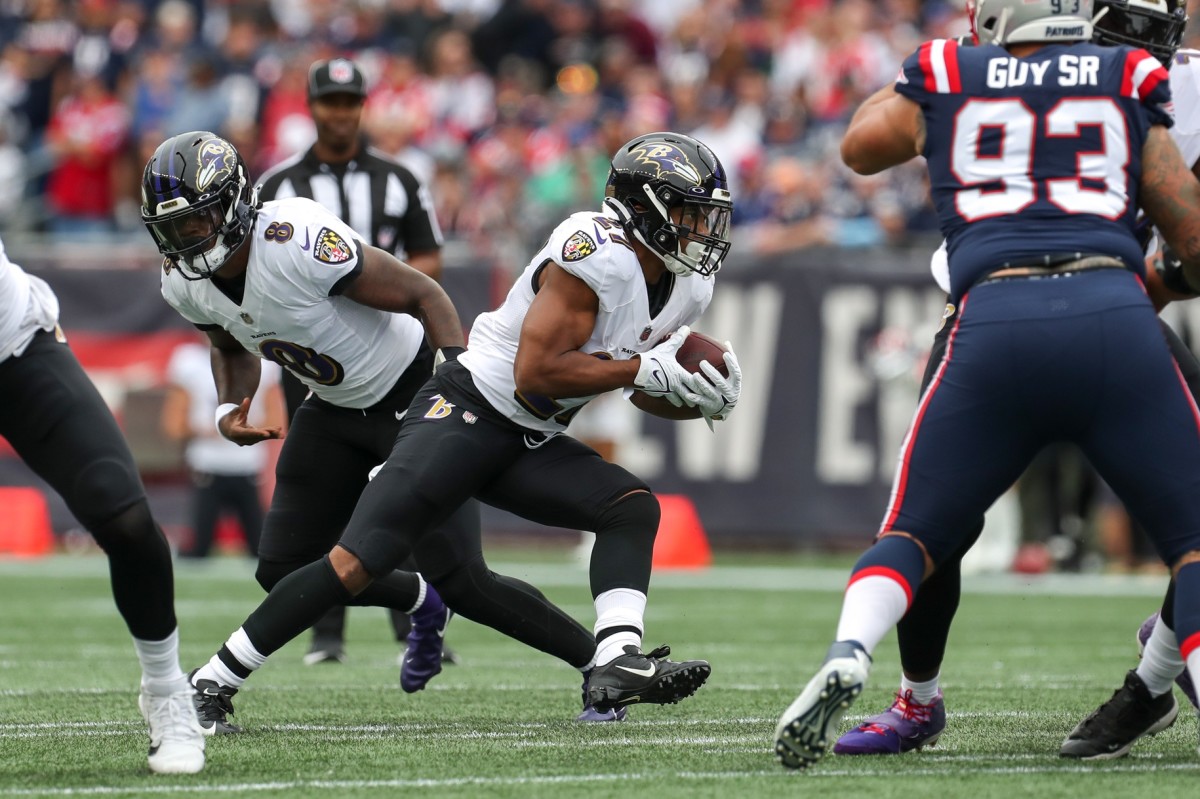
Running Backs
The Ravens run offense gets a major boost from Jackson’s contributions. Yet, he cannot take every rush for the team, and that means massive improvement will be needed from the department after an inconsistent 2021 campaign.
Last season, the Ravens held one of the best rushing units in the entire league kudos to Jackson, but they were marred by countless injuries before the first ball even soared. Running backs Justice Hill and J.K. Dobbins suffered season-ending ailments in the offseason, nixing their third and second seasons with the Ravens, respectively.
As a result, Baltimore had to scavenge the free agent market throughout the season to acquire healthy legs to fill the backfield. In total, the team used seven non-quarterback rushers in 2021, with only three starting more than five games and another three scratching over 100 yards rushing to contribute the 2,479-yard sum at the end of the year.
Entering 2022, most of those names that took carries for the team are gone, and the team will be relying on a tandem of running backs to pick up the slack that Jackson can’t handle. That duo is the returning Hill and Dobbins.
Playing in his fourth professional season for the purple and black, Hill has established himself as the Ravens’ lead ball carrier through five games. After posting a career-high 58 carries for 225 yards and touchdowns in 2019 and a dismal 60 yards in 2020, the Oklahoma State product trails only Jackson on the rushing list with 19 rushes for 125 yards and an average of 6.6 yards per rush.
Standing at 5-foot-10 and 200 pounds, Hill is a very undersized player for his role, but he makes up for it with a flashy tempo out of the backfield and an insatiable toughness running along the interior.
Displaying outstanding ball security once he receives the pigskin, Hill takes off like his hair is on fire and maintains that pace with steady feet and a wide base.
More often than not, he elects to follow play-side blockers and search for daylight on the interior, but he has sharp footwork and lateral cuts to push the run out wide or change direction and race up the other side of the field.
Once he escapes into the open field, Hill is hard to bring down with his shiftiness to rid himself of tackles or his nimble hips for balance and recovery against contact by chasing defenders. He also isn’t afraid to slam on the brakes from a full spring and bounce east-west into new rushing lanes, leaving second-level coverage in the dust.
Hill’s production has been severely limited in the last two games, the latter against a tough run defense in the Buffalo Bills that kept him to eight rushes for 45 yards. The Giants' aggressive interior defense is another tough test up front, but he might be able to strike a few blows if the unit falls asleep on his athleticism in space.
Backing up Hill, third-year running back J.K. Dobbins is healthy off an ACL injury that placed his entire 2021 campaign on the IR list. A 2020 second-round pick by the organization out of Ohio State, Dobbins is returning after a rookie outing in which he accumulated 134 carries for 805 yards and nine touchdowns. In his career, he’s totaled 162 rushes for 913 yards and ten touchdowns, the most recent score coming in Week 4 against Buffalo.
While Hill tends to be the creative back with the wiggle moves to make something happen along the edge, Dobbins is the team’s high-volume, downhill ball carrier with a tough, “lunch-pail” running style. At 5’10”, 212 pounds, the 23-year-old boasts a chiseled, compact frame that empowers him to step into the interior gaps, smack any A-gap rushers, and push through contact to move possessions forward.
Dobbins consistently runs with low, squared pads and makes sure he gives a pop to the defenders before they manage to bring him down. If he can slip into the second level, expect him to activate his good peripheral vision and foot skills to make a tight cut, stretch the play toward the outside and attempt to beat the pursuit to the marker.
Dobbins doesn’t possess the same speed and shifty athleticism to break out huge plays or be a threat in the passing game. Still, the Ravens like to get him involved in screen schemes, where the back does a good job at selling the slip screen and taking attention off one of the receivers to create an open man. Dobbins can also create separation and tally yards after the catch on angle routes to help the team extend drives.
With 28 rushes for 108 yards and a touchdown under his belt, Dobbins has all the strength and efficiency in serving as the Ravens’ third down back in crucial situations. He should expect to get a share of the snaps Sunday with an off-the-ball role of picking up some A-gap blitzes in pass protection against the Giants’ pressure-heavy scheme.
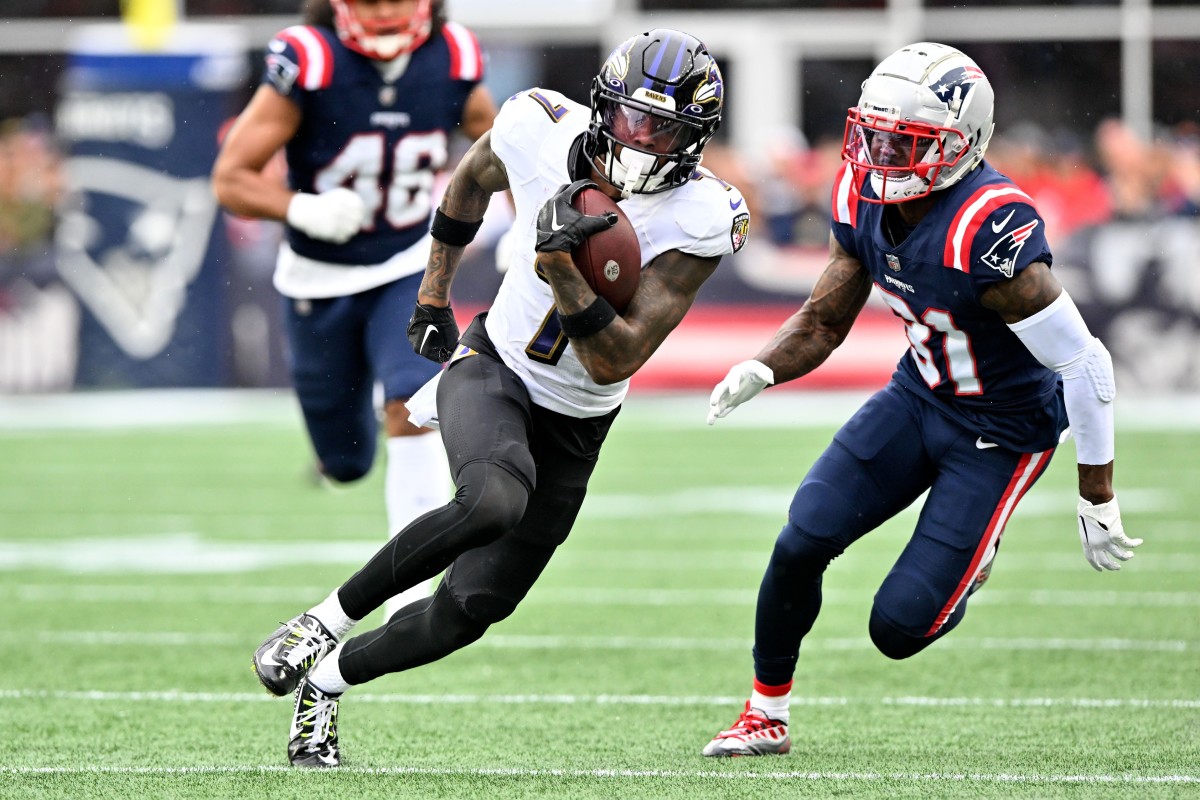
Wide Receivers
While the Ravens’ feature their tight ends heavily in the passing game--their lead receiver is Mark Andrews--they do have a couple of pass catchers at the top of their ranks to prepare for.
The first and foremost true receiver on their starting roster is Rashod Bateman. A 2021 first-round pick out of Minnesota, the 22-year-old Bateman is coming off a rookie campaign in which he finished third amongst Baltimore receivers with 46 receptions for 515 yards and one touchdown. In 2022, he leads the department with 11 catches for 243 yards and two touchdowns, both coming in the first two weeks of the season.
Relative to the teammates in his unit, Bateman is the Ravens’ speedy, short-route receiver with agility and elusiveness to make the most of the space allotted by the defense. In either two receiver sets or out wide alone in 11-personnel, Bateman earns his production running short to medium yardage slant, dig, come back, and flat routes. He then uses quick cuts and lateral angles to extend the play, create space and collect a few extra yards upfield.
Standing at 6-foot-1 and 193 pounds, Bateman also possesses the combination of size and upper-body strength to counteract the most talented press-coverage defenders and win the gritty fight for catch space on contested targets.
Coming off the snap, the 22-year-old deploys his pro-ready hands and a diverse set of press release moves to shed off the tight corner and get to the top point of his route. If that point is vertical and met by multiple defenders, he exercises his limber body frame to extend and pluck it cleanly out of the air.
After Bateman, the Ravens' wide receiver corps also features third-year pass catcher Devin Duvernay. Hailing from Texas, where he played his college ball for the Longhorns, Duvernay was a 2020 third-round pick of the Ravens and has achieved three consecutive seasons with 200 yards receiving and two seasons with at least two touchdowns.
Through five games this year, Duvernay holds 17 receptions for 226 yards and three touchdowns (career-highs) to stand as the third-most productive receiver on the Ravens’ depth chart. On the flip side, he was drafted to serve as the Ravens’ straight-line speedster and vertical threat out of the slot.
Standing at 5-foot-11 and 200 pounds, Duvernay doesn’t boast great size to compete against press coverage directly off the snap, and some of his route-running tends to fall on the average side. Yet, dismisses those inadequacies with a combination of great hands, long-ball speed in zone coverage, and power to add yards after the catch.
Benefiting from his high school track background–he was a 100-meter state champ–Duvernay explodes into the open windows of the zone where he can settle in for a quick catch-and-run. If the defender bites down on the play, he can throw the fake with his hips and blast back up vertically to establish space and create a deep ball toward the endzone.
If coverage becomes clingy again, Duvernay can mimic his teammate in Bateman by plucking balls out of the air or nestling them from the tight throwing lanes with his athletic hands. Then if he unearths enough physicality, he can dip into the first round of tacklers and drag them along for extra yardage and first-down conversions.
Forcing him to make a play along the sidelines is no concern of Duvernay’s either, as he has some of the best sideline awareness in the league to jump vertically and stretch his feet back south to maintain the completed catch inbounds.
Beyond Bateman and Duvernay, sixth-year veteran Demarcus Robinson is the only other receiver with the slightest ounce of production. A former Chief for his first five seasons, the 28-year-old Robinson has just six receptions for 49 yards and a touchdown. The remainder of their receiving contributions is insignificant catches on occasion from the running backs.
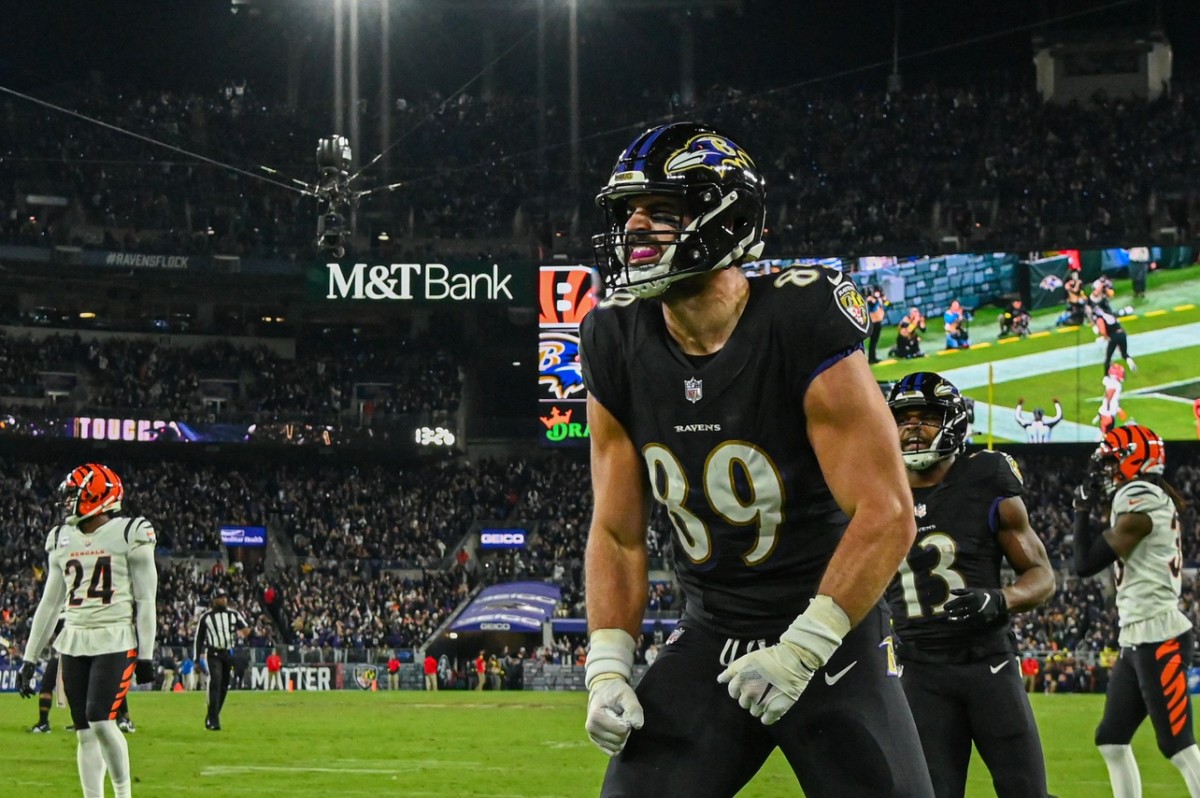
Tight Ends
For the second straight week, the Giants defense could face a one-man wrecking crew at tight end, this time in the form of Mark Andrews.
Playing in his fifth professional season for Baltimore, Andrews has increasingly become the team’s biggest pass-catching weapon, especially inside the red zone. Last season, the 2018 third-round pick finished as the leader in receiving yards and touchdowns, posting 1,361 and nine, respectively, to rank among the top tight ends in the league.
In 2022, Andrews again got off to a hot start with 32 receptions for 349 yards and four touchdowns in his first five games. His production is making opposing defenses pay attention to him in Ravens’ passing schemes, as he currently ranks eighth and fourth overall in the former and latter categories.
Whereas some tight ends gain their production on short crossing routes or last-second dump off for conversion yardage, Andrews is a pure deep-threat player in the Ravens’ offensive game plan. In watching his film from 2021, it was rare to find him shedding off a block into the short field or remaining back as a blocker.
Standing tall and athletic at 6-foot-5 and 256 pounds, the Ravens like to line Andrews upon the slot, taking a position either on the inside end or between two receivers in a three-wideout formation. From there, Andrews will be sent on deep-field drag routes and corner routes that he can turn into big receptions close to the sideline.
Occasionally, the Ravens will feature Andrews as the lone player on the outside. In these instances, it was common to see the tight end take a more vertical approach and attempt to beat around the opposing corner for an over-the-top lob pass from Jackson. Andrews is also one of the best players in his position at getting over the defender and securing the football at its highest point, a skill that makes him one of the quarterback's favorite targets.
Another notable component of Andrews’s game is his ability to see the whole field and shift his route toward open spaces in coverage at different levels. If the Ravens play him from the edge of the offensive line, Andrews will take a flare route toward the flat and reverse it inside on a tiered wheel route.
When Baltimore gets down close to the goalline, Andrews excels at cutting back on his route and running across the plain to an open slot where Jackson can sling a tight ball into his chest for the score. It’s critical for opposing defenders to never ease up on the tight end, even if a play is going in the other direction, as Andrews will always be a threat to come back around and link up with his quarterback when all other options are exhausted.
Behind Andrews, the Ravens also mix in some snaps with rookie Isaiah Likely, the team’s fourth-round pick in April’s draft out of Coastal Carolina. However, through five games, he’s been deployed more as an upfront blocker in 12-personnel schemes, earning only seven receptions for a minimal 58 yards.
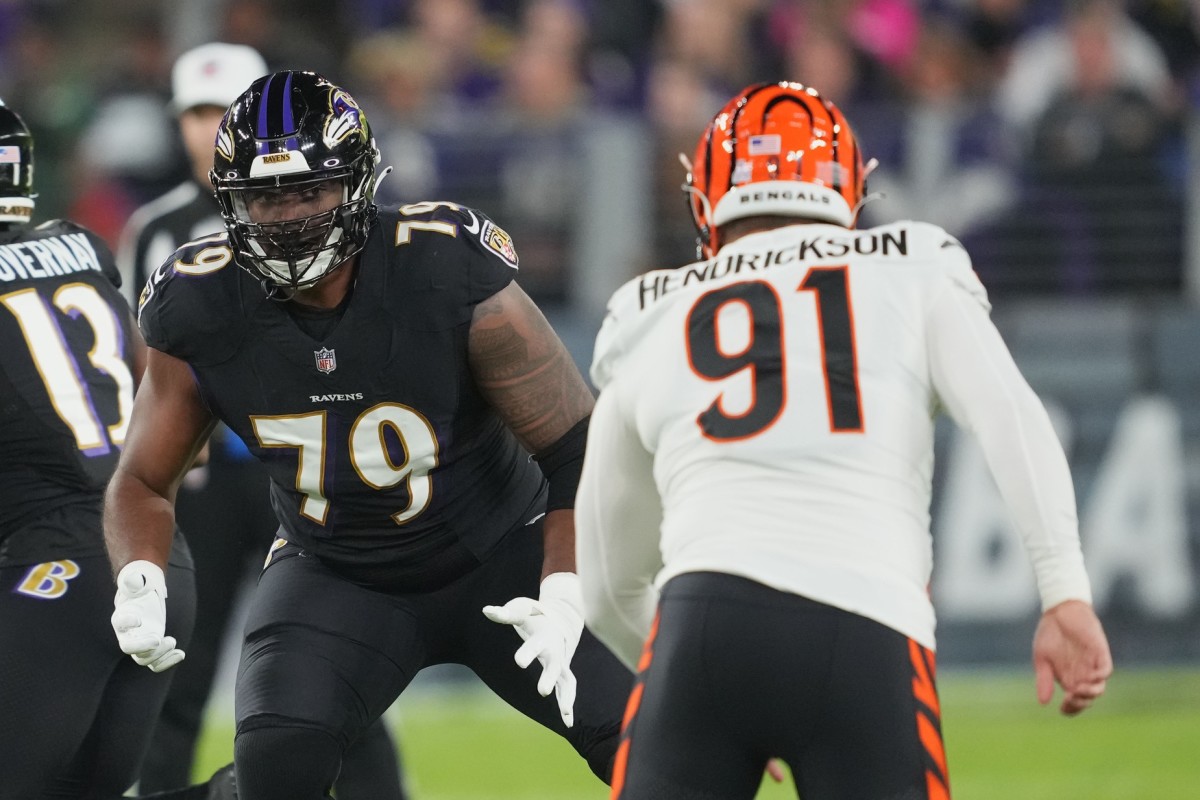
Offensive Line
Even with the dynamic abilities of Lamar Jackson behind them, there were instances last season when the Ravens knew they had to bolster their offensive line if they wanted to protect the long-term health of their quarterback and the overall success of the passing game.
Throughout 2021, Baltimore suffered from the woes of an offensive line marred by inconsistency and injuries, slowing down the dangerous impact of Jackson’s arm and landing him on his back in the biggest games. As a result, the Ravens invested draft capital and significant free agent money into fortifying their line with a group of veterans capable of championship-worthy protection.
With their newest starting additions to the trenches still intact through Week 5, the Ravens’ offensive line has ridden overall projections towards the top five in the league, including a sixth-ranked pass block ranking and eighth-ranked run block rating. The team hopes it stays together to usher in more success for Jackson and the passing attack, two keys to the Ravens' quest for a deep playoff run.
Holding down the left side at the tackle position is Ronnie Stanley. A seven-year veteran and former 2016 first-round pick of the Ravens, Stanley has been regarded as one of the most elite left tackles in the league. His excellent protection along the edge has been credited as a major catalyst in Jackson's development and past success.
The recent problem with the 2019 Pro Bowl left tackle is that he’s rarely been available until recently. Before Week 4, Stanley had missed 31 of the Ravens’ past 32 games with an ankle injury. In his absence, the team has blown through three left tackles in the first three games this season, including one rookie lineman who didn’t traditionally play the position in college.
If Stanley can remain healthy through the rest of 2022, the Ravens can rest assured of the protection he will provide against the pass rush. In 2019, he allowed the fewest pressures (six) by an offensive tackle in 14 years, according to Pro Football Focus. That feat earned a massive contract extension in 2020, a reason the Ravens want to get him back on the field.
Following Stanley is fourth-year left guard Ben Powers. The Oklahoma Sooners product was a 2019 fourth-round pick by the Ravens and earned the position after beating out the competition in training camp. He has experience playing at both guard spots in his career, but thus far, he has been considered a developmental piece instead of an all-world left guard.
Whenever he’s on the field, Powers operates with a fiery, grudge-holding demeanor that extends back to his college days when he has to play at the junior college level before earning a scholarship. He plays with a burly, wide frame and comes off the snap with a strong twitch to set solid initial contact on the opposing defender.
Powers is developing his bend and athletic ability to compete better with the best inside pass rushers in the game. Still, he remains competitive at the line using his strength and excellent pass-blocking technique. Coming off the line of scrimmage, he maintains a square composure and body balance in his pads and throws a heavy-handed first punch straight to the defender’s frame.
Once locked into his opponent's frame, he has good hand positioning and core strength to withstand upper-body power rushing moves in front of him. Powers excels at sealing angle blocks and can work on double teams and work-up blocks. If the defender puts on twist moves, the 6-foot-4, 310-pound guard can pass them along to the outside tackle to keep an open running lane down the middle.
At the center position, the Ravens have their one piece of youth on the offensive line in rookie Tyler Linderbaum. A 6-foot-2 and 305-pound player and No. 25 overall pick out of Iowa, Linderbaum came to the Ravens because of his football intellect and his sound technique on display at the college level.
Despite concerns about his size making block finishing hit or miss against bigger defenders, Linderbaum is another scrappy player with a wrestling background who loves to compete in the rushing attack. That tenacity shows best in his attention to detail before and after the snap when he looks to establish position control.
Linderbaum’s background allows him to establish a good core balance and body control before he takes off from the snap, where he comes off with quickness and an explosive lift against the nose tackle. In the positioning phase of the block, he tends to win by getting his eyes and hands to the point of contact. Then, he locks in and uses his harmonious body movement to stick with the defender while the rushing lanes open up.
If he ever is beaten by a bigger, faster defender off the ball, Linderbaum has the reactive agility to recover and buy extra time for his quarterback in the pocket on the passing game. As the play extends downfield, he knows when and where to climb to the second level for angle blocks, where he can break down on the fly and find work on moving targets.
The Ravens believe Linderbaum has Pro-Bowl potential, and his best route is a move-based rushing attack. Yet, he has a chance to thrive in the passing schemes with the right matchups and his desire to bring any muscle he has to opposing rushers.
Shifting to the right guard position, the Giants defense will be met by a familiar face in Kevin Zeitler. The eleventh-year veteran spent two seasons with New York from 2019-2021, splitting time between the two guard positions on their starting offensive line. He departed for Baltimore in free agency, returning to the AFC North division after stints with Cincinnati and Cleveland.
Baltimore sees Zeitler as a solid starting addition to the offensive line not only for his veteran experience, but because of how exceptional he was in pass protection last season. As a Giant, the 32-year-old played in all 17 games and finished as one of the cleanest blockers in the position, allowing just one sack in over 1,200 pass-blocking snaps.
With a younger Powers to the other side of him, the Ravens are looking towards Zeitler as a mentor who turns his teammate into another franchise material player at the left guard spot. Establishing a strong pass rush on both sides of the line is more likely if he remains healthy to help in the trenches down the season's stretch.
Wrapping up the starting line is ninth-year right tackle Morgan Moses. The former 2014 third-round pick of the former Washington Redskins was signed in free agency after spending the 2021 season with the New York Jets to replace Alejandro Villenueva in the run game after the linemen decided to retire from the NFL.
The team may need to work on improving Moses into a serviceable run blocker, but he surely upgraded the right tackle position in the passing game. Last season, he finished with a 91% pass block win rate, a feat that ranked 16th best among active tackles. It’s fair to expect the Giants to see a tougher challenge in getting Lamar Jackson on the ground from that side as long as Moses is holding down the fort.
Join the Giants Country Community
- Sign up for our FREE digest newsletter
- Follow and like us on Facebook
- Submit your questions for our mailbag
- Check out the new Giants Country YouTube Channel.
- Listen and subscribe to the daily LockedOn Giants podcast.
- Subscribe and like the LockedOn Giants YouTube Channel
- Sign up for our FREE message board forums
- Get your Giants tickets today from SI Tickets!
-1ca98c375b90186224f7ec5e456f6e73.webp)